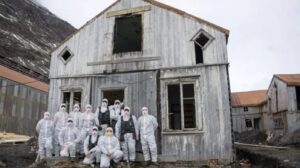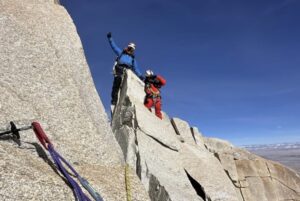At the eastern end of the Himalaya lies a mysterious world of colossal, unclimbed 7,000m peaks. Little known, they offer tantalizing challenges for true mountaineers.
A few expeditions have explored the area and made some interesting climbs. We take a look back at the first and only ascents of Gyala Peri and Namcha Barwa, two gigantic mountains, separated by the Yarlung Tsangpo river.
Two brothers
One of the many local legends says that Namcha Barwa and Gyala Peri were two brothers sent to Earth from Heaven to guard southeastern Tibet. Gyala Peri, the younger brother, was highly intelligent, talented, and taller than his brother Namcha Barwa. Namcha Barwa became jealous and killed his brother, throwing away his head. God punished him, ordering him to guard the Yarlung Tsangpo river and accompany his beheaded brother forever.

Namcha Barwa. Photo: Sebastian Alvaro
The legend explains why the top of Gyala Peri is rounded. Namcha Barwa, on the other hand, is almost always hidden by mist and clouds because he feels ashamed.
Locals say that whoever sees the top of Namcha Barwa from afar will have prosperity and good luck throughout the year.

The north face of Gyala Peri. Photo: Tamotsu Nakamura
The first ascent of Gyala Peri
Gyala Peri, next to Rakaposhi in the Karakoram, is probably the largest abyss climb on the planet. It has a prominence of 3,000m and vertical walls that reach the banks of the Yarlung Tsangpo river.
At 7,294m, it is the highest peak in the Nyenchen Tanghla range but is often included in the Namcha Barwa Himal group of the Himalaya. It is north of the great bend of the Yarlung Tsangpo river and north-northwest of Namcha Barwa.

On the far right of the map, you can spot Namcha Barwa and Gyala Peri, marked with red points. Photo: Michael Ward
In 1985, the Himalayan Association of Japan sent two men to scout the mountain. One year later, the Japanese returned. The group of six climbers, under the leadership of Kazuo Tobita, found the approach very difficult. It did not stop raining, and the group had to cross the river to reach the Gyala Peri base camp.
Finally, the party established their base at 3,200m on September 16. They intended to climb the west face via the south ridge.
Six days after arriving at base camp, they began their climb. On September 25, they established an advanced base camp at the foot of the west face, at 4,200m. The first two altitude camps were on the face itself. At 6,000m, they gained the south ridge, reaching Camp 4 at 6,751m on October 21. Their determination was unwavering, despite the snowfall they had to contend with.
At the end of October, they made two summit attempts, both unsuccessful. The third time was the charm. On October 31, 1986, one day after the second failed attempt, Yasuhiro Hashimoto, Yoshio Ogata, and Hirotaka Imamura topped out on Gyala Peri.

The Yarlung Tsangpo River. Photo: Sebastian Alvaro
Second ascent attempt
In September 1998, a Spanish group from Al Filo de lo Imposible attempted the second ascent of Gyala Peri. The group included brothers Felix and Alberto Inurrategui, Inaki Ochoa de Olza, Juanjo San Sebastian, Jose Carlos Tamayo, and Jon Lazcano.
Hounded by bad weather and enveloped by a fog that completely reduced visibility, the party ascended the Japanese route. They managed to reach 6,000m, where they met a bear! The team members ran, never a good idea with bears, but they were fortunate to get down from the mountain safely. They abandoned their attempt.

Tibetan brown bear. Photo: Yunchuan Dai
Namcha Barwa’s hidden face
On the eastern side of the Great Canyon of Yarlung Tsangpo lies 7,782m Namcha Barwa.
The Epic of King Gesar, one of the great epic poems of Tibet, described Namcha Barwa as “a lance piercing into the sky”. The name can also mean “rocks falling from the sky”. In the Tibetan language, the name means “burning thunder”. Locals also call it the “Shy Lady Peak” because clouds almost always hide its snowy summit.
Namcha Barwa is worshiped as home to the gods. According to legend, there are seven golden temples on the peak. Locals say that although Namcha Barwa stands in the human world, it never shows its true face to humans.

Namcha Barwa from the air. To the right is Mount Sanlun (7,059m). Photo: Japanese Alpine Club
The first expeditions to Namcha Barwa
First described by British surveyors and explorers in 1912, Namcha Barwa immediately drew the attention of mountaineers when it appeared in photographs produced by Britain’s 1913 Bailey Expedition. However, for a long time, there were no attempts to climb the mountain.
The easternmost peak on Earth with an altitude higher than 7,600m, Namcha Barwa is unusually verdant, with evergreen rainforests and a multitude of plants and animals in the river valley at lower altitudes. Above 4,500m, the mountain is permanently covered by ice and snow.

Clear weather gives a rare glimpse of the summit of Namcha Barwa. Photo: Sebastian Alvaro
In the 1980s, it drew the attention of Chinese researchers and mountaineers. Science teams made expeditions in August 1982, April 1983, and April 1984 to investigate the region’s flora, fauna, and climate.
On April 21, 1984, they climbed 7,043m Naipun, the mountain adjoining Namcha Barwa. They ascended via its steep southwest flank, full of avalanche danger. From there, they could see six possible routes up Namcha Barwa. However, every route seemed very complex, featuring mixed snow, ice and rock.
Between November and December 1990, a joint Chinese-Japanese expedition, composed of four Japanese and six Chinese mountaineers, scouted the west-northwest and south ridges, under the leadership of Tsuneo Shigehiro. They also reached 6,900m on neighboring Naipun.

Namcha Barwa (left) and Naipun peak. Photo: John Town
A brave attempt and tragedy
In the fall of 1991, the Japanese Alpine Club obtained permission to carry out a joint Japanese-Chinese expedition to Namcha Barwa.
Six climbers from the Japanese Alpine Club and six climbers from the Chinese Mountaineering Association reached base camp at 3,520m on September 28, 1991. The group started up Naipun, and on October 13, they reached 4,850m.
On October 16, an avalanche killed Hiroshi Onishi, one of the team’s top climbers. The shocked group stopped for 10 days, but resumed the following week. Huge snowfalls and strong winds tested them severely, but on November 15, they established Camp 4 at 6,900m.

Namcha Barwa from base camp in 1992. Photo: Japanese Alpine Club
From Camp 4, they went down to the col between Naipun and the summit of Namcha Barwa. Then they continued up the steep slope of Namcha Barwa. On November 19, they set up Camp 6 at 6,700m. From that point, the group set ropes to 7,200m. The next day, they reached the base of a dangerous rock band at 7,350m. Here, they had to make a tough decision: Because of heavy snowfall, there was high avalanche danger.
They decided not to give up. On November 22, they returned to rock band and managed to get through the entire section. After all that effort, reaching 7,460m, they ran into more avalanche danger and finally abandoned their attempt.
The first ascent
The Chinese-Japanese team went back to Namcha Barwa a year later, in the fall of 1992. The joint group included Japanese climbers Kazuo Yamamoto, Tsuneo Shigehiro, Toichi Mitani, Hiroshi Aota, Atsushi Yamamoto, and Masunori Satoh; plus Chinese climbers Sanju, Da Chimi, Jiabu, Tsering Dorje, Bianba Zhashi, Da Chimi, and Da Chiong. They climbed via the south ridge over Naipun.

Namcha Barwa, Camp 6, and Naipun seen from 7,350m. Photo: Japanese Alpine Club
Between October 13 and 21, they made several summit attempts. Each time, they had to turn around because of bad weather and descend to base camp. On October 24, they started climbing again, determined to make it to the top.

Images of the rock band and the snow ridge of Namcha Barwa’s summit. Photo: Japanese Alpine Club
On October 29, six climbers made it above the rock band, up to 7,600m. Again, the bad weather returned. This time, they decided to bivouac while the rest of the climbers continued to ascend behind them. One of the following group (Shigehiro) turned around at the rock band, but the rest of the party made it to 7,600m.
Finally, on October 30, 11 climbers reached the summit of Namcha Barwa.

The route of the first and only ascent. Photo: Kazuo Yamamoto
Like Gyala Peri, Namcha Barwa has only been climbed once. Years later, the authorities halted all climbing in the area for both religious and political reasons: The Yarlung Tsangpo later flows into India.

On the summit of Namcha Barwa. Photo: Japanese Alpine Club
Below, a documentary of the first ascent of Namcha Barwa. (Sorry, Japanese only)






